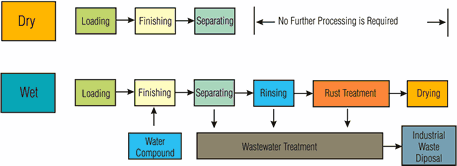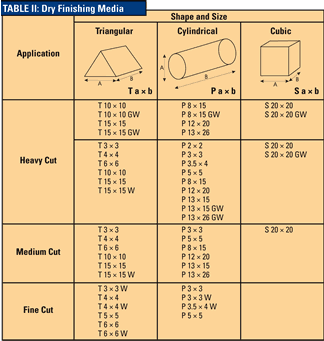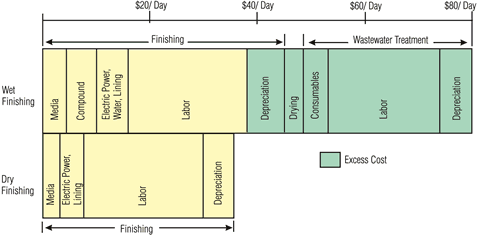Part III Mechanical Finishing: A Review and New Technologies
Part III covers factors that need to be considered when discussing media and compounds...
Combining a binder with an abrasive produces media. The most common binder is ceramic followed by plastic. More aggressive media uses a higher percentage of abrasive while light-duty media uses little abrasive and a lot of binder.
Larger media cuts more because it imposes more force on the part. Smaller media does not, but equipment such as high-energy disk and barrel equipment can compensate for this. The size can also allow for more surface contact on the part with shapes such as triangles and pyramids that have large flat surface areas. In choosing media, however, shape is very important. The media selected must contact all areas of the part that require finishing. The trick is to do this without creating any lodging problems. A good lab can again aid you with this selection based on its experience. Sizing out media that has worn is critical to avoid lodging but is rarely done. Your equipment, in many cases, can be designed to handle this. For aggressive media that wears quickly, your machine should be capable of sizing out worn media.
Most media uses aluminum oxide as the abrasive due to its favorable cost versus performance ratio. Silicon carbide media is used exclusively for finishing operations that will be followed by welding or brazing as aluminum oxide can flare up. Plastic media uses a wide variety of “softer” abrasives for use on softer metals and different materials. Plastics are effective for pre-plate and pre-polish finishing as they are designed to produce smooth finishes. Plastics generally are not as aggressive and will require longer time cycles. See Table I for types of media.
Compounds:
There are so many compounds available that choosing the right one can be difficult. Most compounds are liquids, not powder, so that they can be set up on a meter or dosing pump and automatically introduced to the process. Compounds are responsible for keeping media clean, inhibiting, cleaning parts and the process, carrying away contaminants, brightening and modifying the action of the equipment. In other words, they have quite an effect on the entire process and should be a well-understood and maintained parameter. Compounds are often changed for what is often a minimal savings with little understanding of how it will change the process.
Over or under compounding during the process can cause the process to fail by not cleaning properly, allowing rusting or not aiding in the polish. If the operator is responsible for this, the likelihood of improper compounding rises sharply. Most compounds are used at a concentration of 2%, which only pumps and meters can maintain properly.
The water quality is also important as it makes up 98% of the solution. In critical operations, the pH and hardness should be monitored. Re-using water is difficult since it is changed each time it is introduced back to a process. Even well-filtered water has compound remaining that makes it impossible to maintain the proper solution.
Dry Finishing
Eliminating water from the finishing compound has been a goal of deburring for some time. With its elimination comes savings, including the cost of water, compound and what has now become the expensive treatment and disposal of wastewater. While there are dry organic media used to polish parts, very effectively in high-energy machines there has been little progress in dry metal removal. The challenge, as attempts were made to run standard wet media in wet equipment in a dry environment, became repeatability. Wet media simply could not keep its surface cleared for adequate performance in a dry environment.
The solution came from the development of a special media and the adaptation of existing mass finishing technologies. Starting with the centrifugal disk technology, the equipment was adapted for air collection instead of the gravity fill and drain used on wet applications. Once proper airflow was achieved through the unit, it worked well with the newly produced dry media. The surface of the media stayed clear, and the process was continually effective. The technology was then adapted to the centrifugal barrel and then vibratory finishers.
The advantages of dry finishing are as follows:
- No wastewater treatment
- No compounds
- Cleaner work environment
- Reduce risk of rusting
- Minimize water surface tension thatcauses parts to stick together
- Lower operating cost
- Reduce deformation of parts
- Reduce surface hardening of parts
The finishing applications possible are:
- Deburring
- Descaling
- Radiusing
- Edge break
- Surface improvement
- Polishing
Table II shows the media available.
This new generation of media is made of special resins and an abrasive mix. The media is highly porous, reducing clogging by dust and other fine particles during the process. In combination with the adapted equipment, the dry media produces a high cutting capability and overall improved efficiency.
The attrition of the media can run from 4-25 times less than comparable wet cut media. In addition to overall savings from improved efficiency, this reduces problems coming from media mixes that have not had small media sized out. This also reduces the risk of low media levels that change the parts to media ratio and can change the dynamics of the process.
When comparing wet media with dry, the dry cuts the same but wears less and also leaves an improved surface finish. The following charts provide a comparison of wet finishing to dry finishing. See Figures 1 and 2 for a comparison of wet and dry finishing.
Another advantage of the dry process is that the parts exiting the machine are virtually dust free. Because of the low attrition, less contaminants are produced. An air collection system pulls these contaminants away from the process. Except for certain critical applications, this eliminates the need for subsequent operations such as washing, drying and additional inhibiting. The dry parts are also easier to handle out of the machine.
At one bearing location, the braces finished in a dry centrifugal disk were found to be cleaner and less likely to rust then parts from their wet disk process. m
Typically, the dry process would require the purchase of equipment for the process. In recent years, wet process vibratory mills have been adapted to run dry successfully. Not all machines can be adapted, but the cost is low if this is possible and the saving are high, especially if you have wastewater concerns.
In conclusion, the purpose of this article was to bring an improved understanding of the mechanical mass finishing process. Identifying and defining the many variables that make up and affect the process is the key to controlling and optimizing this process. Finishing does not need to be “black magic,” but time does need to be spent learning it. The difficulty with mechanical finishing is that the variables can fluctuate but need to stay in a defined range. Gaining an understanding of these variables and the allowable range for each will reduce the problems found in the finishing area. This, along with a reputable vendor, will allow you to find the needed improvements in your mechanical finishing processes. And most likely, because of a lack of understanding, no one has properly defined the process yet or the potential for savings, so the opportunity is still there.
Finishing Associates, LLC
Read Next
Education Bringing Cleaning to Machining
Debuting new speakers and cleaning technology content during this half-day workshop co-located with IMTS 2024.
Read MoreEpisode 45: An Interview with Chandler Mancuso, MacDermid Envio Solutions
Chandler Mancuso, technical director with MacDermid Envio discusses updating your wastewater treatment system and implementing materials recycling solutions to increase efficiencies, control costs and reduce environmental impact.
Read MoreA ‘Clean’ Agenda Offers Unique Presentations in Chicago
The 2024 Parts Cleaning Conference, co-located with the International Manufacturing Technology Show, includes presentations by several speakers who are new to the conference and topics that have not been covered in past editions of this event.
Read More




















.jpg;maxWidth=300;quality=90)








